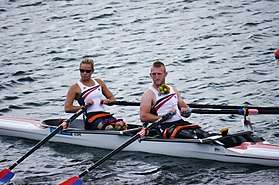Adaptive rowing

Oksana Masters & Rob Jones of the USA in the mixed sculls (TA 2x) final at the Paralympics, London 2012. The rowers are fixed to the seat.
Adaptive rowing is a category of rowing race for those with physical disabilities. Under FISA rules there are three categories for adaptive rowers:
- PR3 (previously LTA - Legs, Trunk, Arms)
- Use of at least one leg, trunk and arms. Also for those with visual and intellectual impairments. Rowed with standard boats and sliding seats.
- PR2 (previously TA - Trunk and Arms)
- Only use of trunk muscles. Boat has fixed seat.
- PR1 (previously AS - Arms and Shoulders)
- Limited trunk control. Boat has fixed seat and rower is strapped at upper chest level to only allow shoulder and arm movements.
At FISA events there are 5 boat events (standard nomenclature is used):
- 4+ Mixed PR3
- 2x Mixed PR3
- 2x Mixed PR2
- 1x Men PR1
- 1x Women PR1
Racing was held over 1,000 m (rather than the standard 2,000 m), but from 2017 the distance was changed to the standard 2,000m.[1] In mixed events half the crew must be male and other half female (coxswain may be of either gender and may be able bodied). Single shells for the PR1 category must have stabilising pontoons attached to the riggers.
Adaptive events were added to the World Rowing Championships in 2002 and took place at the 2008 Summer Paralympics in Beijing, China.
References
- ↑ "Summary of proposed changes to the FISA Rules of Racing, related Bye-Laws and Event Regulations" (PDF). FISA. Retrieved 13 February 2017.
External links
| Wikimedia Commons has media related to Adaptive rowing. |
- FISA Para-Rowing page
- Adaptive Rowing on International Paralympic Committee website
- Rowing Canada's Para-Rowing Page
- British Rowing's (UK) Domestic Adaptive Rowing Page
- USRowing's Domestic Adaptive Rowing Page
This article is issued from
Wikipedia.
The text is licensed under Creative Commons - Attribution - Sharealike.
Additional terms may apply for the media files.